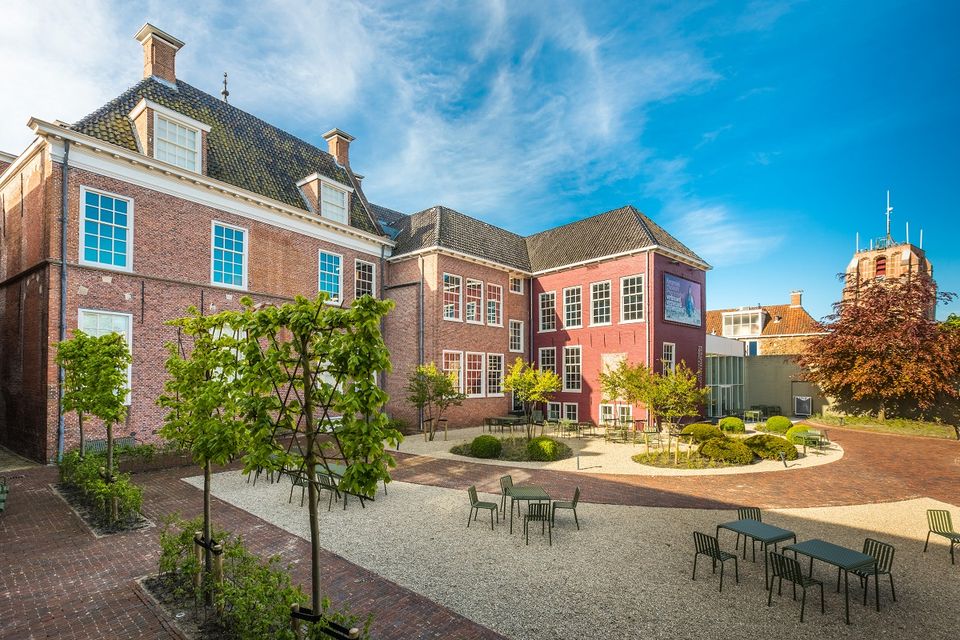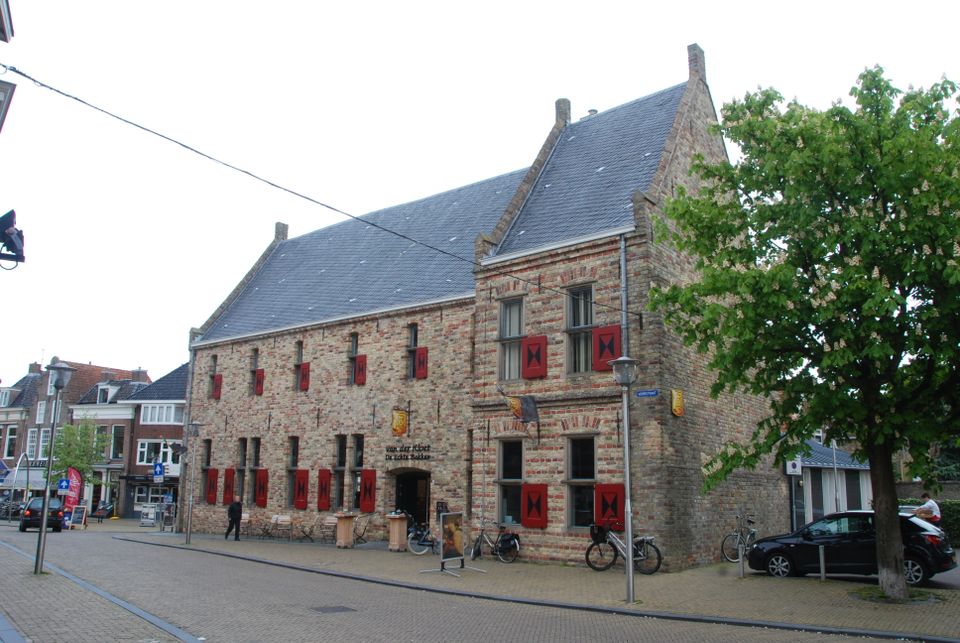From the capital to mudflats
Take a look
View all 5 pictures
Start your bike tour in Leeuwarden. Willem Lodewijk van Nassau-Dillenburg, the nephew of William of Orange, became the first Frisian Stadtholder here in 1584 during the Eighty Years' War. In the beginning, the Frisians were not too fond of him but eventually he got the nickname 'Us Heit' (Our Father).
This Frisian branch of the Nassau family continued the extinct Orange branch in 1702 and are therefore the direct ancestors of the current Dutch royal family. As regent for William IV, Maria Louise van Hessen-Kassel was the last separate stadtholder of Friesland. She was also loved in the city and was therefore called Marijke Meu (aunt Marijke).
To get into a noble mood, you can fir…
Start your bike tour in Leeuwarden. Willem Lodewijk van Nassau-Dillenburg, the nephew of William of Orange, became the first Frisian Stadtholder here in 1584 during the Eighty Years' War. In the beginning, the Frisians were not too fond of him but eventually he got the nickname 'Us Heit' (Our Father).
This Frisian branch of the Nassau family continued the extinct Orange branch in 1702 and are therefore the direct ancestors of the current Dutch royal family. As regent for William IV, Maria Louise van Hessen-Kassel was the last separate stadtholder of Friesland. She was also loved in the city and was therefore called Marijke Meu (aunt Marijke).
To get into a noble mood, you can first take a tour of the city, past the old houses of the Nassaus. The Stadhouderlijk Hof dating from 1564 was originally built for the steward of Philip II of Spain. In 1587, Willem Lodewijk went to live there and so it became the Stadhouderlijk Hof.
After her regency, Maria Louise had the Princessehof built. She actually had a number of houses merged into one royal residence. The Frisian members of the House of Orange were buried in the Grote Kerk (church), where they had their own entrance. You can recognise it by the Orange tree above the gate.
From Leeuwarden you then cycle to the western wadden region. The Frisian nobility came from the various villages in this area. These rich Frisian families, such as the Van Burmanias, Van Eysingas and Van Cammingha, had a lot of power and influence. They did not accept the Frisian stadtholders because they saw the Naussaus as interlopers and they considered themselves more important. Frisian political relations and intrigues of that time resemble soap operas.
The families lived in large country estates or manors. Many villages had such manors. The nobility also had beautiful gardens laid out in their country estates. Many of these manor houses remained in the hands of the same families for centuries. The route takes you along different manor houses and castles that are reminders of the rich history of prosperous Friesland.
Sights on this route
Starting point:
Waypoint bike 26
Leeuwarden
Navigate to starting point
Waypoint bike 26
Leeuwarden
Navigate to starting point
Fletcher Hotel-Paleis Stadhouderlijk Hof
In the heart of Leeuwarden city centre, you will find the magnificent Fletcher Hotel-Paleis Stadhouderlijk Hof.

Fletcher Hotel-Paleis Stadhouderlijk Hof
Fletcher Hotel-Paleis Stadhouderlijk Hof
Hofplein 29
8911HJ Leeuwarden
The Princessehof National Museum of Ceramics
In the middle of Leeuwarden's historic city centre stands the 18th-century city palace of Maria Louise van Hessen-Kassel, princess of Orange Nassau, ancestor of King Willem-Alexander. The world-famous M. C. Escher was also born in the same building.

The Princessehof National Museum of Ceramics
The Princessehof National Museum of Ceramics
Grote Kerkstraat 9
8911DZ Leeuwarden
Grote of Jacobijnerkerk
The Grote of Jacobijnerkerk is the oldest and, from an architectural point of view, the most important church in Leeuwarden.
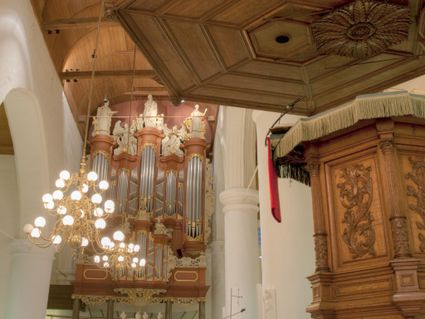
Poptaslot of Heringastate
Poptaslot, the jewel among the Frisian Stinzen, called, to the last States and occupant, the wealthy lawyer Dr. Henricus Popta. From his death in 1712 the estate with gardens, canals and ports increasingly managed by 4 guardians. The decor is still m...
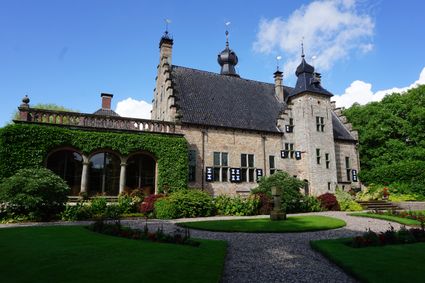
Camminghastins
In het centrum van Franeker staat de Camminghastins gedateerd rond 1500. Kom eens gezellig een kop koffie drinken in de Camminghastins, want tegenwoordig huist er een een konditorei.

Botniastins
Sinds 2017 is in de historische Botniastins de nieuwe Franeker Academie gehuisvest. Er worden lezingen gehouden, bedrijven en instellingen kunnen er vergaderruimten huren, en er worden onderzoeksprogramma's uitgevoerd.
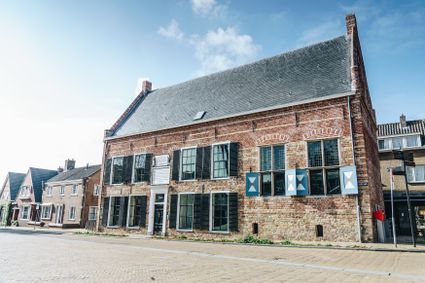
Museum Martena
Museum Martena is the museum of the city of Franeker. Traditionally Franeker is one of the eleven cities of Friesland, it has a historic center with canals, a street plan dating from the Middle Ages and many remarkable old buildings.
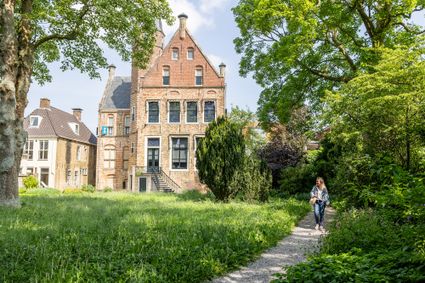
Liauckemastate
Eén van de grootste state van Fryslân. Een archeologisch rijksmonument waarvan de prachtige poort nog intact is.
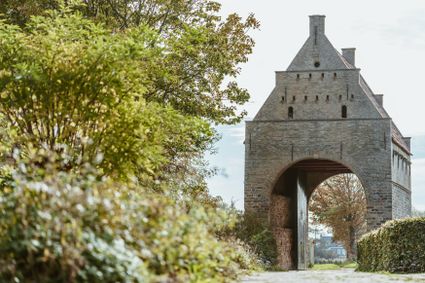
Roptastate
De Ropta State een monumentale boerderij met herenhuis en prachtig aangelegde tuin.
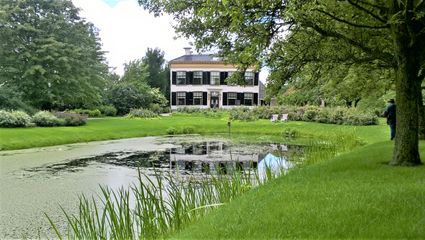
Hemmemapark Berltsum
Vrij toegankelijk park dat zich bevindt op het terrein van de oude Hemmemastate.

Landgoed & Slot Martenastate
In 1899 is de oude state afgebroken en vervangen door een “slot”. Dit gebouw bestaat nog steeds en is gelegen op het eiland in de slotgracht. Het park heeft een romantisch karakter met elementen uit de Engelse landschapsstijl en een zeer rijke stinzenflora.

Camping Martenastate
Je kunt heerlijk rustiek kamperen op Landgoed Martenastate; geniet van de natuur, het gefluit van de talrijke vogels en de schone lucht. Je vindt het intieme natuurkampeerterrein van Landgoed Martenastate verscholen achter en in de luwte van een statige rij eeuwenoude beuken.
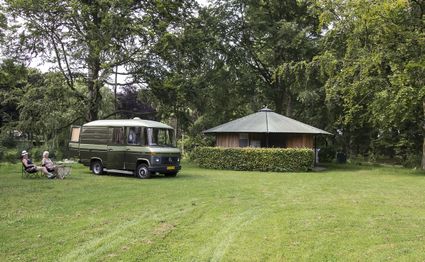
Dekema State
Dekema State was originally a noble residence, where several families lived until 1996. The noble residence and the gardens are now open to the public.
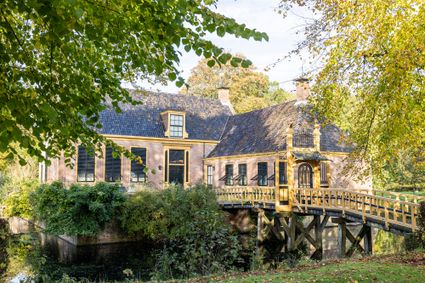
End point:
Waypoint bike 26
Leeuwarden
Navigate to endpoint
Directions
Starting point:
Waypoint bike 26
Leeuwarden
Navigate to starting point
- Wilhelmina tree
This linden tree was planted in 1898 on the occasion of Wilhelmina's accession to the throne. The fence is decorated with the Appeltjes van Oranje (i.e. oranges). - Us Heit
Willem Lodewijk van Nassau-Dillenburg was stadtholder of Friesland from 1584 until his death in 1620. He was nicknamed Us Heit (Our Father). This statue was created partly thanks to the efforts of Queen Wilhelmina. She was also the one who unveiled the statue in 1906. - Stadhouderlijk Hof
The house of Willem Lodewijk van Nassau-Dillenburg and his wife and niece Anna van Nassau. Over the years, the building has been expanded and rebuilt by the various stadtholders who lived here. The gate on the right is still original. This former palace remained the property of the royal family until 1971. Today it is a hotel. - Princessehof
After her regency, Maria Louise had the Princessehof built in 1731. She actually had a number of existing buildings, including the remains of the 15th century Papingastins, merged into one royal residence. Maria Louise also had an important porcelain collection and the residence is now a beautiful Ceramics Museum, where you can see the baroque-style dining room of Maria Louise and her ceramics collection. - Grote or Jacobinkerk (church)
This is the church frequented by the Frisian Nassaus. At the end of the 17th century, the stadtholders got their own bench to sit on: the stadtholder pew. Various members of stadtholder families are buried in the church, including Anna van Nassau, the wife of Willem Lodewijk. The Oranjepoort (Orange gate) is located on the east side of the church. The stadtholders used to enter the church through this door. - Heringa manor (Poptaslot)
Also take a look at the lovely courtyard residence around the corner from the manor on the Hegedyk, which is a legacy from Popta, who had it built as a poor women's guesthouse. Single ladies could spend their old age here without any worries. The courtyard residence was built in 1711. In 1713, a beautifully carved entrance gate was built on the Buorren. The now modernised houses are still inhabited. - Schatzenburg manor house
Dronryp was known as a stately village because of the dozens of manor houses located there. Dating from 1725, Schatzenburg is the only manor house that has survived. It was inhabited by Mr Hermannus Huber, his wife Elisabeth de Hertoghe, and his unmarried brother-in-law Christiaan de Hertoghe. Huber was a member of the Provincial Executive of Friesland, and De Hertoghe was secretary to Prince Johan Willem Friso and later to his widow Maria Louisa van Hessen-Kassel (Marijke Meu). You can only visit the park during Open Monumentendag (Heritage Days) on the second weekend of September. On other days you’ll have to make do with a view of the garden from the Rypsterdyk. (To get to Schatzenburg manor house, cycle towards Junction 84. The manor is located to the left of the third roundabout on the Eastryp. Cycle back to Junction 61 and continue the route) - Botnia stins (stone manor) (Klein Botnia)
Botnia stins has a turbulent history. In the 17th century the founders and inhabitants, the Roman branch of the Botnias, were expelled from Franeker with the expulsion of the Spaniards. In 1588 Anna van Nassau, the wife of the first Frisian stadtholder Willem Lodewijk, died here at the age of 24 during her first pregnancy. And in the 18th century, several professors from Franeker University lived here. One of them was Johannes Lemonon, who had Stadtholder Johan Willem Friso as a student. He would have received the prince in his home. Today, the Franeker Academy is located in Klein Botnia. - Cammingha House
The east facade of Cammingha House, also known as Sjaerdemahuis, is a remnant of a stone manor from around 1400 and may have been founded by Sicke Sjaerda, the first resident. Over the years, the Van Cammingha, Juckema and Van Burmania families have owned the property. There’s now a bakery in it, where you can get the tastiest (stinzen) bread. - Martena House & Museum Martena
Martena house or stone manor was built in 1498 by order of nobleman Hessel van Martena. The property was inhabited by his descendants until 1694. After that, Suffridius Westerhuis, mayor of Franeker, bought Martena House. He drastically renovated the house immediately after buying it. Museum Martena has been located in the building since 2006. You can learn more about the history of Franeker in the museum. There is also a permanent exhibition about Anna Maria van Schurman, who, in the 17th century, became the first woman in the Netherlands to study at a university and who spoke fourteen languages, in which she also corresponded with the European philosophical leaders of her time. And of course you can also admire the beautiful house. - Martena garden
When Mayor Surffridius Westerhuis bought Martena House, he immediately left his mark on the design of the garden. He was inspired by the French style. The garden was redone again in around 1834, this time by landscape architect Lucas Pieter Roodbaard. The garden now took on more characteristics of the English landscape style. Martena garden has a lot stinzen plants and is free to visit. - Gatehouse of the former Liauckama manor
Liauckama manor was owned by the oldest and most important Frisian families for centuries. It was demolished in 1824, but fortunately the gatehouse still stands. Liauckama manor is known for the 'Pipenpoyse Bruiloft' (Pipenpoyse Wedding). These are two paintings showing the wedding of Jel Liauckema and Eart van Pipenpoy circa 1616. They show guests dancing and eating and are therefore the first wedding report in the Netherlands! The paintings can be seen in the Fries Museum (The farm that now stands is not freely accessible). - De Kraak van Dam
If you’re looking for a special place to sleep, this former Reformed church is highly recommended. The organ of well-known organ builder Van Dam is still in its original place, as is the pulpit. A unique experience! - Mariakerk (church): entrance portal Elgersma manor
The entrance to Mariakerk is decorated with a beautiful portal. This portal from 1664 is all that remains of Elgersma manor, which was demolished in the early 20th century. The Elgersma family’s manor house used to be on Dongjumerweg, east of the church. - Rest stop B&B Dyksterhuzen
Need a break? Rest stop Dyksterhuzen is located near Bitgummole. Here you can enjoy the views of Stiens, Ingelum or Leeuwarden in the beautiful tea garden. Something else that’s good to know for when it’s warm outside... they also have ice cream. - Martena manor
The current castle was built in 1899 on the site of a 15th century manor that was demolished that same year. The old manor house was inhabited by the Martena family in the 15th and 16th century. The current house is not freely accessible, but the beautiful landscape park around it is. In the spring you can fully enjoy the beautiful stinzen plants here. The impressive gate at the park’s entrance is also special because it used to adorn the Landscape House in Leeuwarden next to the Chancellery. In the 18th century, the Provincial Executive of Friesland gathered here. In the mid-19th century, the Landscape House was demolished and the gate moved to Martena manor. - Túnmanswente
This used to be the gardener's house of Martena manor. Since 2006, Túnmanswente has been run by students from Friesland College and Nordwin College. Long forgotten vegetables are grown in the lovely tea garden. It’s wonderful to sit here with a coffee or tea and listen to the birds singing in the background. Visit the shop before moving on, where you can get the tastiest regional products. - Dekema Manor
Dekema Manor was built in the 14th century and was still a stone tower at that time. Over the centuries, the stone house grew into a noble manor house inhabited by, among others, the Camstra, Dekema and Van Wageningen families. The latter family lived there for over 200 years. Dekema Manor is now a museum. When walking through the building, you can see elements from the various periods. The vintage wildflower garden (stinzentuin) is also a true paradise, laid out in the old style and maintained with a lot of love. There are flower borders, an orchard, a greenhouse and a cut flower garden. In the spring, beautiful stinzen plants brighten up everything.
End point:
Waypoint bike 26
Leeuwarden
Navigate to endpoint
- 26
- 26
- 91
- 64
- 63
- 61
- 76
- 77
- 61
- 44
- 92
- 29
- 09
- 15
- 12
- 69
- 40
- 43
- 86
- 80
- 97
- 88
- 41
- 81
- 78
- 75
- 98
- 87
- 10
- 23
- 66
- 65
- 64
- 91
- 26
- 26
